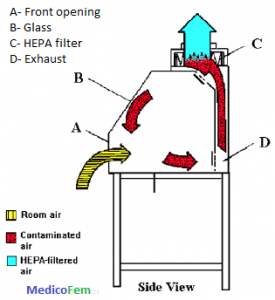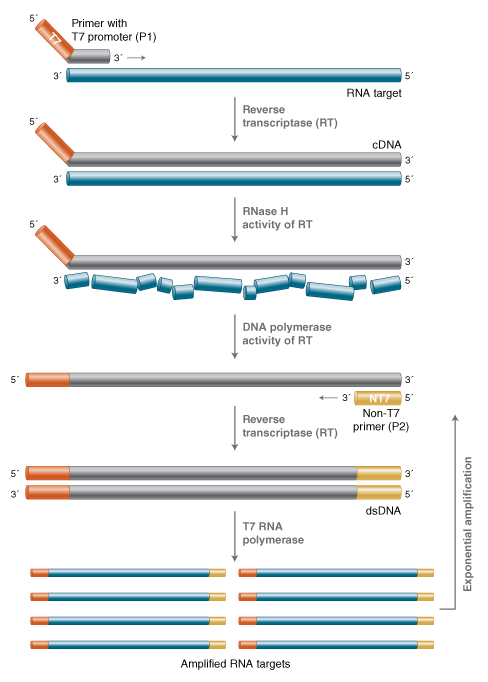Biosafety:
Biosafety is the measures employed to avoid infecting oneself, others or the environment when handling biohazard materials
Biohazard:

An agent of biological origin that has the capacity to produce deleterious effects on humans, i.e. microorganisms, toxins and allergens derived from those organisms.
Examples;
- Microorganisms such as viruses, bacteria, fungi, and parasites.
- Blood and body fluids, as well as tissues from humans and animals.
Biosafety Levels
Four biosafety levels provide increasing degrees of protection against various pathogenic microorganisms
- Level 1:
- Suitable for work involving well-characterized agents not known to cause disease in healthy adult humans and of minimal potential hazard to laboratory personnel and the environment.
- Examples: Bacillus subtilis, E. coli
- Level 2:
- Suitable for work involving agents of moderate potential hazard to personnel and the environment
- Examples: Measles virus, Salmonellae, Toxoplasma species, Hepatitis B virus
- Level 3:
- Suitable for work with infectious agents which may cause serious or potentially lethal disease as a result of exposure by the inhalation route.
- Example: Mycobacterium tuberculosis
- Level 4:
- Suitable for work with dangerous and exotic agents that pose a high individual risk of aerosol transmitted laboratory infections and life threatening disease.
- Example: Ebola Zaire virus
Containment:
Containment includes safe methods for managing infectious materials in the laboratory environment where they are being handled or maintained.
Purpose: is to reduce or eliminate exposure of laboratory workers, other persons, and the outside environment to potentially hazardous agents.
Primary Containment: Protects personnel and the immediate laboratory environment from exposure to infectious agents
Provided by: good microbiological technique, appropriate safety equipment (including personal protective equipment), and vaccines (where applicable)
Secondary Containment: Protection of the environment external to the laboratory from exposure to infectious materials
Provided by: combination of facility design and operational practices
Safety Equipment: (Primary Barriers)
These are designed to remove or minimize exposures to hazardous biological materials.
Examples:
Biological Safety Cabinets, safety centrifuge cup, personal protective equipment (PPE), such as gloves, coats, gowns, shoe covers, boots, respirators, face shields, safety glasses, or goggles
Biosafety Cabinets:
- 3 Classes
- Exhaust – HEPA (High Efficiency Particulate Air)

Bio-Safety Cabinet Diagram
Class I:
⇒ Do not protect the work from contamination
⇒ Air entering cabinet is not filtered
Class II:
⇒ Each type recirculates different amount of air
⇒ Some are hard ducted, and some exhaust into the room
Class III:
⇒ Totally enclosed, ventilated cabinets
⇒ Work through portals with attached glove
Standard Precautions
- Previously this was known as Universal Precautions. Standard Precautions are specific precautions designed to prevent harmful bacteria and viruses from infecting people who are providing first aid or health care.
- As defined by the Centers for Disease Control (CDC); Standard Precautions are a set of practices designed to prevent the transmission of HIV, Hepatitis B and other blood borne pathogens (bacteria and viruses).
- Under Standard Precautions, blood and other body fluids of all patients are considered potentially infectious.
Personal Protective Equipment:
- Gloves / Aprons / Gowns Protective eyewear / Face shields / Masks
Standard Precautions also include:
- Hand washing
- Proper handling and disposal of needles and hospital waste.
- Taking precautions to prevent injury from sharp instruments
Hand Washing:
Hand washing is the MOST IMPORTANT STEP in preventing the spread of disease!
Method:
- Wet your hands with warm water.
- Apply soap.
- Rub hands together and scrub really well.
- Be sure to get under fingernails and in between fingers.
- Scrub for about 10-15 seconds.
- Rinse hands of soap.
- Dry hands well with a clean paper towel or cloth.
Gloves: When to wear gloves?
- Anytime you may come in contact with blood or other body fluids such as urine, saliva, vomit, or the mucous membranes of the mouth or nose.
- When touching skin that may have sores, open wounds, cuts, or scratches.
- When handling any object that may have been soiled with blood or body fluids.
- When you have a cut or scratch on your hands.
Summary:
- Standard Precautions recommend that you treat all bodily fluids as if they are infected with a blood-borne disease.
- Personal protective equipment includes gloves, face shields or eyewear, gowns, aprons and masks.
- Wash hands before putting on gloves and immediately after removing gloves.






